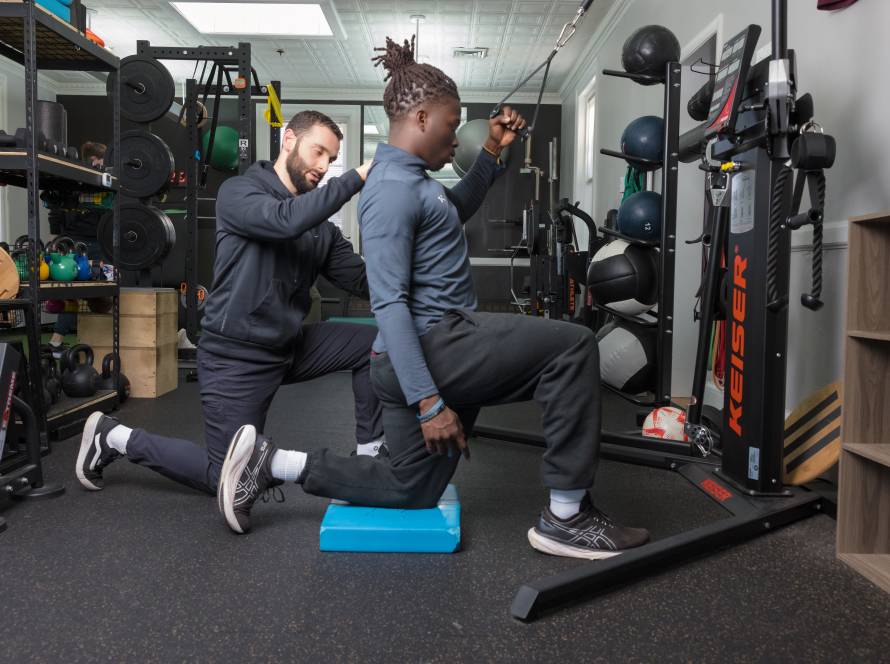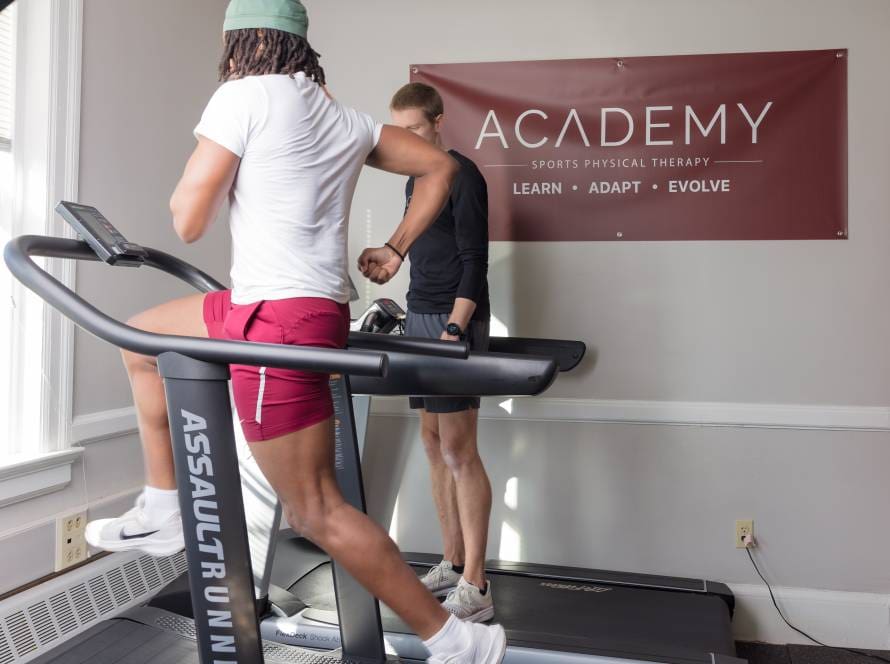Post Objectives:
- Identify and understand the 9 Physiologic Adaptations you can develop through training/exercise.
- Find practical ways of assessing each of the adaptations and provide minimal thresholds to hit (these recommends are rough and will vary significantly depending on the person and goals)
- Create a road map of identifying which adaptions you need to improve.
- Offer a training program aimed at improving YOUR general physical preparation
- Offer world class performance physical therapy services in Providence, RI at Academy Sports PT.
The 9 Physiologic Adaptations:
-
Skill Development: Learn to move better. Improve efficiency, timing, coordination and sequencing etc.
-
Examples: Swinging a golf club, throwing a ball, sprinting, squatting. The list goes on…
-
Skill development is about deliberate practice of the specific skill you are trying to develop. Ideally with a professional who has specific expertise in coaching the skill you are trying to improve.
-
-
Speed= distance covered in a given amount of time (miles/hr)
-
Maximum Velocity (top speed)
-
Acceleration (how quickly you get to top speed)
-
Test: 40 yard dash time
-
How to improve speed: See #3 Power
-
-
Power= Force*Velocity
-
Represents the product of strength AND speed. Both qualities here can increase your power. What weight is “best” for training power Understanding your force velocity curve answers this, stay tuned for future post.
-
Test:
-
Broad jump max distance
-
Max vertical jumo
-
Velocity based training (how fast does the barbell move at a given weight) need a VBT device
-
Force plate testing, need force plates. (Now at Academy Sports PT!!)
-
-
Minimum Benchmarks:
-
Broad Jump Distance: your height
-
Max vertical Height: >24in male >20in female
-
-
-
Strength= How much force can you produce 1 time.
-
Needs to be measured in multiple areas
-
Tests:
-
Max Grip Strength (hand dynamometer)
-
Max Dead Hang time
-
Goblet Squat ISO hold at bottom
-
Many others
-
**never do max testing if you’re not confident in your technique
-
-
Minimum Benchmarks:
-
Grip Strength: Over 40kg and within 10% side to side
-
Dead hang max time: minimum 30 seconds
-
Goblet squat ISO with ½ body weight for 45 seconds
-
-
-
Hypertrophy: How big is your muscle?
-
Aesthetic portion: highly subjective, what do you think looks good?
-
Metabolic portion: minimum amount you want to have regardless of your goals.
-
Minimum Benchmarks:
-
Fat free mass index: >20 Males >18 females
-
There are standardized free calculators online to determine this #. You’ll need your height weight and body fat %.
-
-
-
Muscular endurance: Measures localized muscular endurance in the target tissue of the test
-
What’s the maximum amount of repetitions you in a given exercise?
-
Different tests are required for each body region. Generally trained between 5 – 50 reps
-
Test:
-
Max Pushup
-
Front Plank
-
Side Plank
-
Many others
-
-
Minimum Benchmark
-
Max Pushup: >20 male > 10 female
-
Front Plank: >60 seconds
-
Side Plank >45 seconds each side
-
-
-
Anaerobic capacity: Exert maximal effort aimed at reaching your maximum predicted heart rate
-
Max Predicted heart rate= 220 -age
-
Can you get close to max predicated heart rate (HR)?
-
Test:
-
Sprinting
-
Biking
-
all out till you hit your max HR (usually between 30-120 second)
-
-
Benchmarks:
-
Heart rate recovery:
-
Within 60 seconds of hitting max HR, you should recover ½
beat/minute (30 beat/mins)
-
Within 120 seconds recover 60 beats/min
-
If you’re heart rate recovers less than the above you may have limitations in anaerobic capacity or cardiovascular capacity
-
-
-
-
Aerobic Capacity: VO2 Max
-
What is the maximum amount of oxygen an individual can use during
exercise. *needs to be tested in a laboratory.
-
You can get an approximate VO2 max by performing:
-
Coopers Test: Max distance covered in 12 minutes. Use online calc to get approx. VO2 max
-
1 minute walk test: record total time and heart rate. Use online calculator to get approx. VO2 max
-
-
Minimum Benchmarks:
-
VO2 max minimum: >35 >30 female
-
Vo2 max Optimal: >55 male >50 female
-
-
-
Long duration/Steady State: Maintain consistent work output >20 minutes
-
Your ability to sustain a sub-maximal rate over time without rest.
-
Test
-
Depends on your level of fitness
-
If you cant walk for 30 straight minutes, walking is an appropriate
modality, if you can pace needs to be slightly faster than walking pace
-
-
Minimum Benchmarks
-
No standardized number. Will be specific to the individual and the test.
-
-
Now that the all different adaptations and minimum standards are laid out we can more accurately assess our fitness level.
Some questions to consider:
-
Are you wildly deficient in any adaptation(s)?
-
Are you crazy good in a particular adaptation(s)?
-
Do you have specific performance goals? (powerlifter, marathon runner etc)
-
Is your training protocol focused on developing the right qualities?
-
Are you healthy?
Training needs are highly specific to the individual. What is considered “optimal training” changes from person to person and is based on how you answer the questions above. Meeting minimum thresholds for each of the 9 adaptations is a great place to start to cover your health goals. Once you’ve covered your health bases specific performance goals can dictate which adaptations you hone in on, Having a training plan that is liad out over several months up to a year allows you develop multiple qualitiies effectively.
Sample Athlete profiles: These are made up but will give you an idea of how athletes stereotypically present. There are certainly outliers!!!
-
Marathoner:
-
Skill: Running
-
Speed: 6/10
-
Power: 6/10
-
Strength: 6/10
-
Muscular Hypertrophy: 5/10
-
Muscular endurance: 5/10
-
Anaerobic Capacity: 7/10
-
Aerobic Capacity: 10/10
-
Long duration: 10/10
-
-
Power Lifter:
-
Skill: Squat, Bench, Deadlift
-
Speed: 5/10
-
Power: 5/10
-
Strength: 10/10
-
Muscular Hypertrophy: 9/10
-
Muscular endurance: 7/10
-
Anaerobic Capacity: 6/10
-
Aerobic Capacity: 5/10
-
Long duration: 5/10
-
Each athlete has a particular skillset that makes them suited for their goals. Continuing to develop thier areas of strengths as well as work on areas of weakness is a priority for both!
Outside of athletes preparing for a specific sport or competition taking a more various approach to training allows you to maximize your adaptability. Instead of specializing in one or two adaptions become above average in all nine categories!
If you’re interested in becoming a Jack of All Trades (JOAT) and training variously, My colleague/training partner Dr. Alex Schleper (aka Big Red) and I developed a program aimed at maximizing your General Physical Preparation. That is, your ability to become above average in each category. Training various qualities throughout the year allows you to maximize your adaptability for sustained health and performance in a way that’s fun, challenging and progressive!

We’ll see you on the inside!
Are you currently limited in your ability to train due to pain or injury?
Are looking for more direction in your training?
The performance Physical Therapists at Academy Sports PT are here to help!
 Until next time,
Until next time,
Nick



